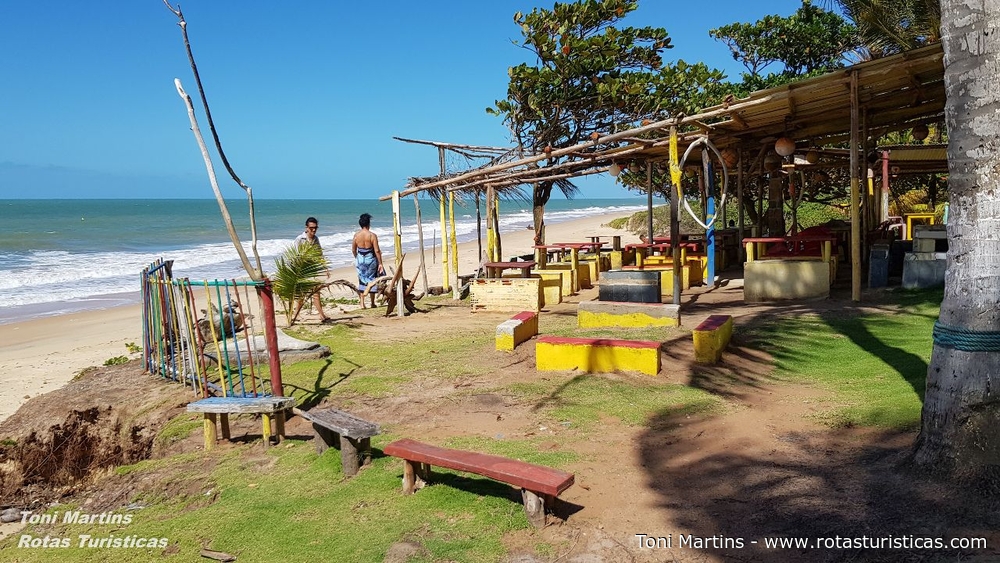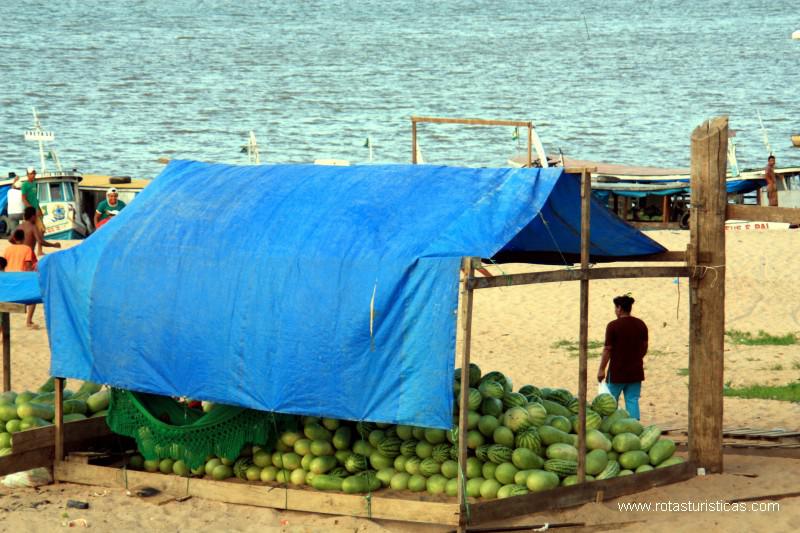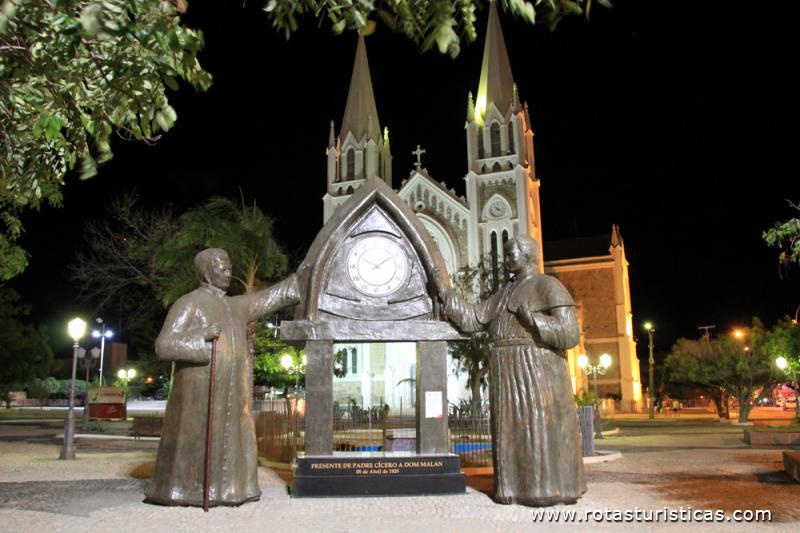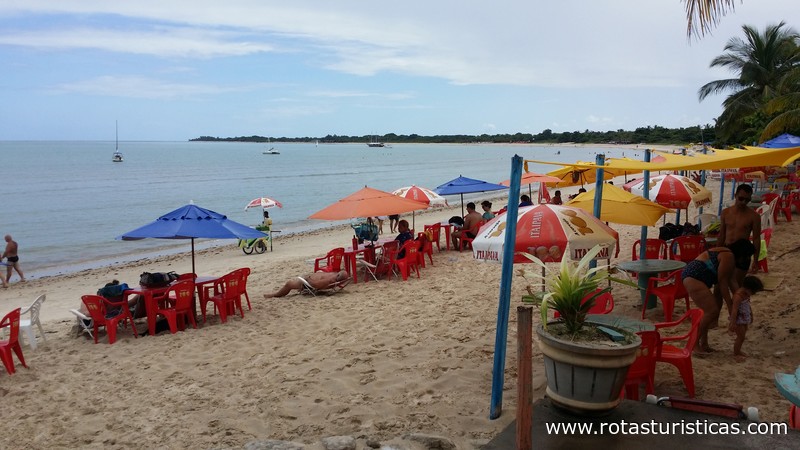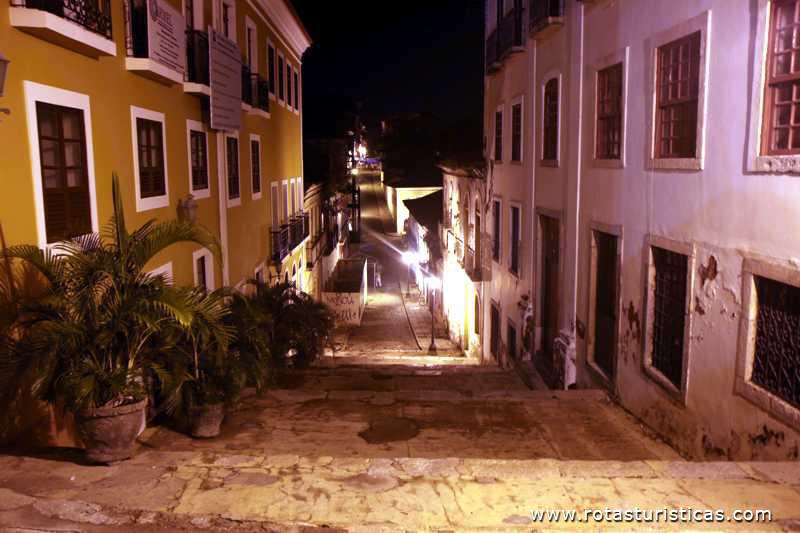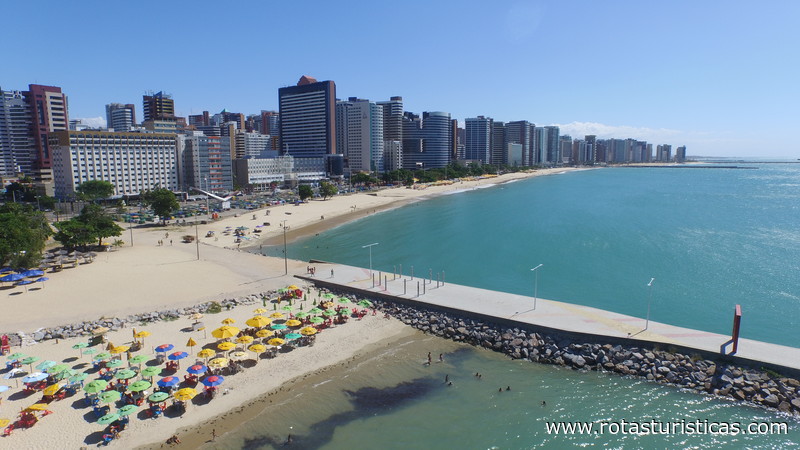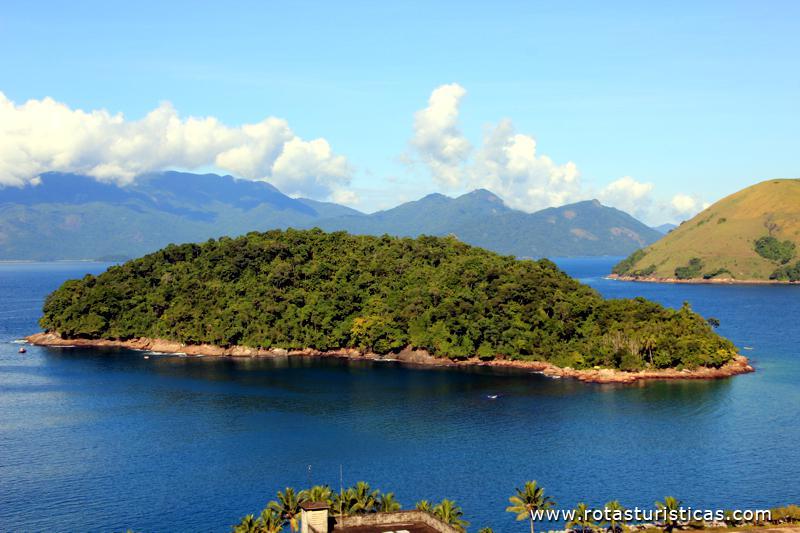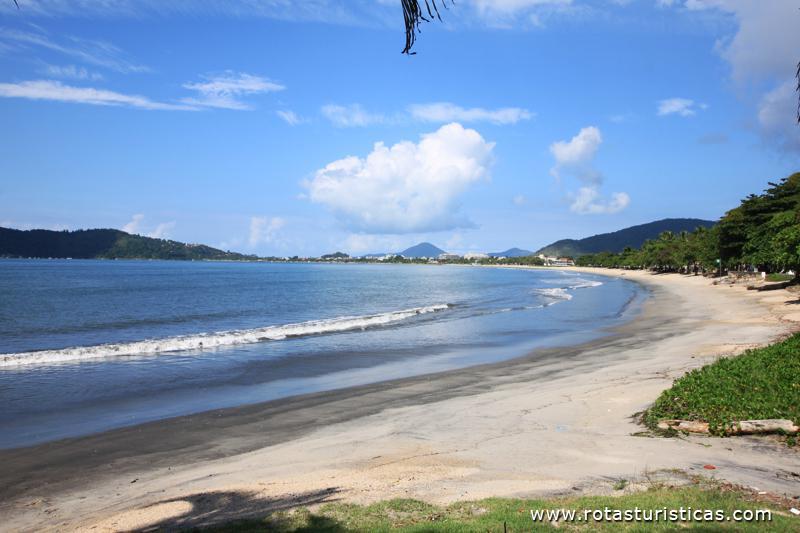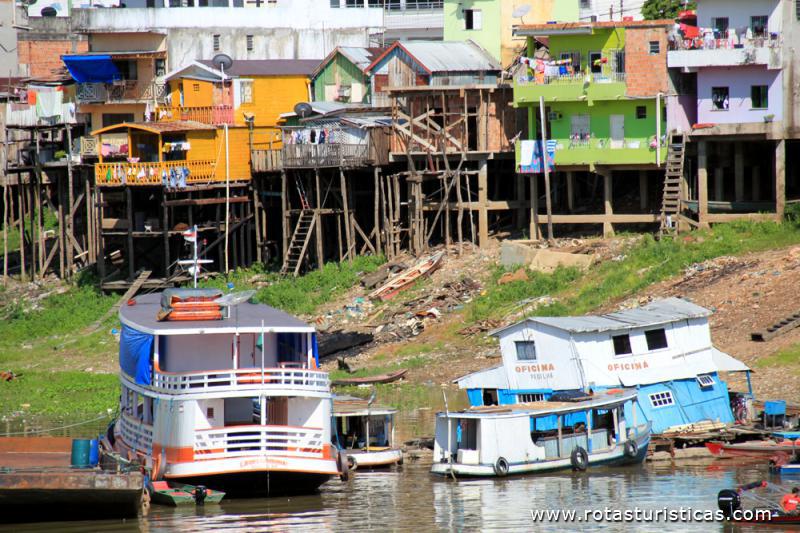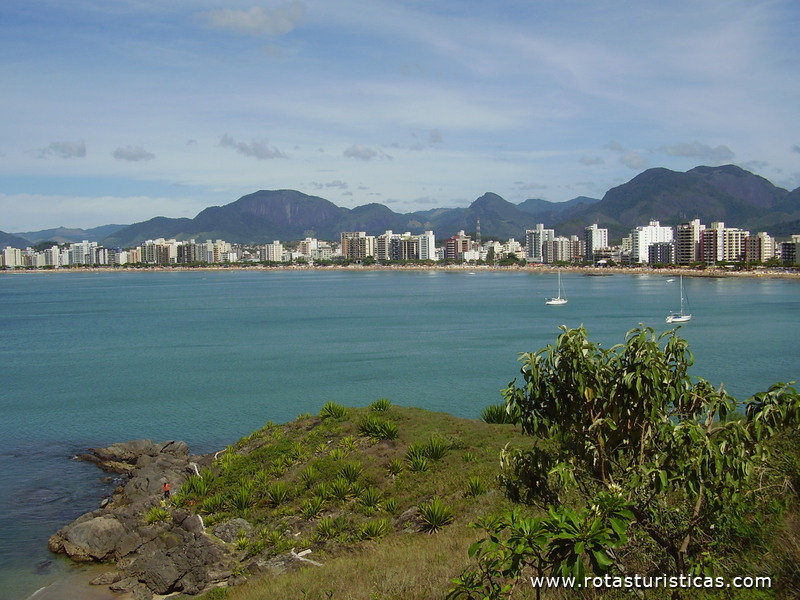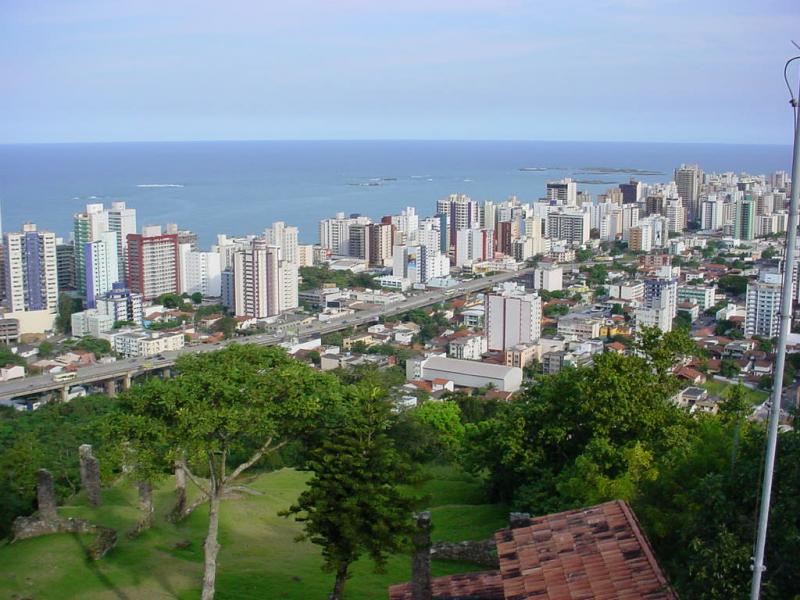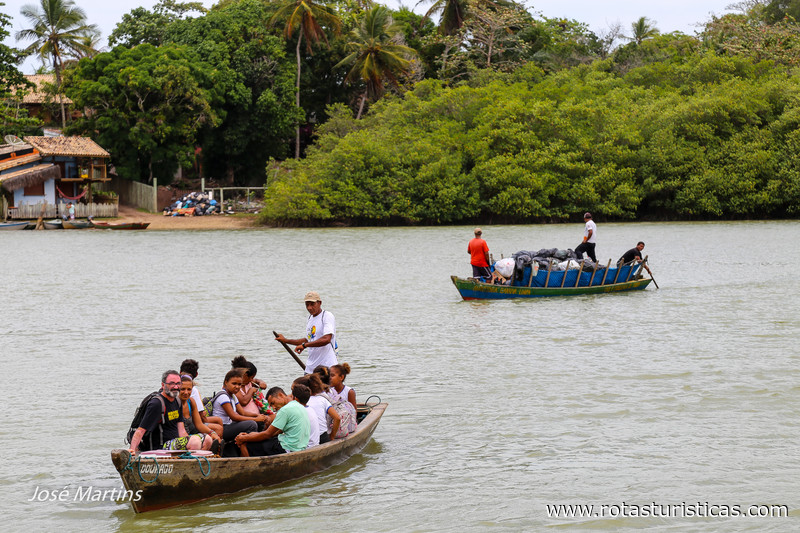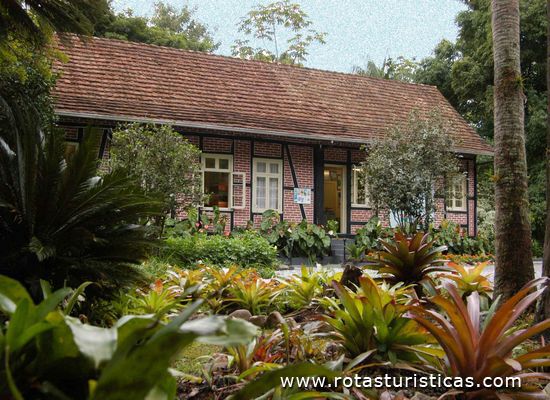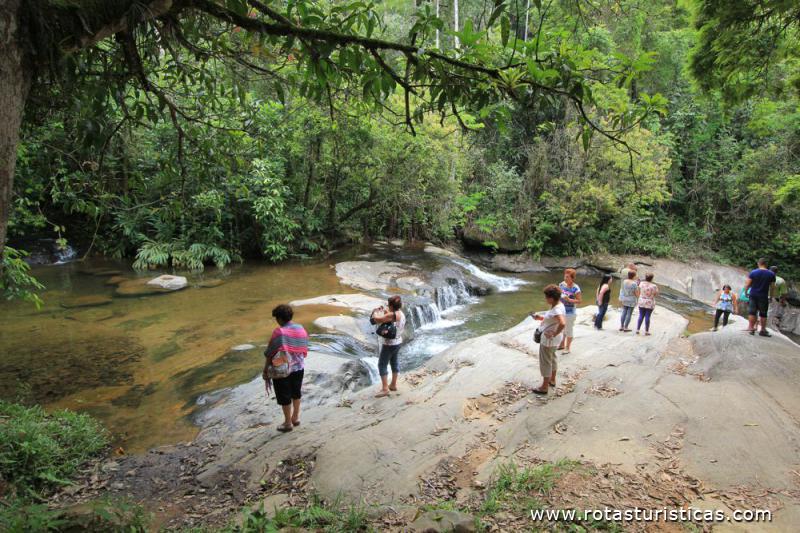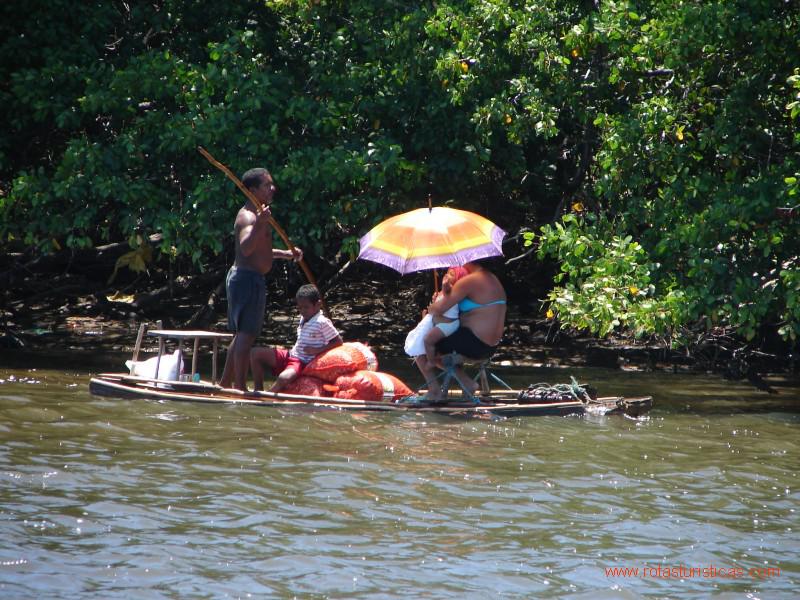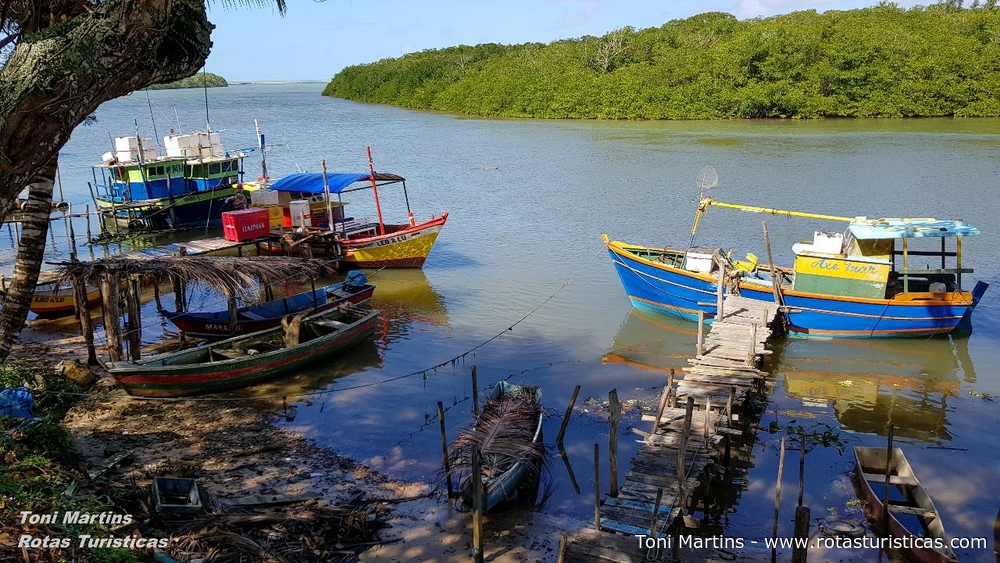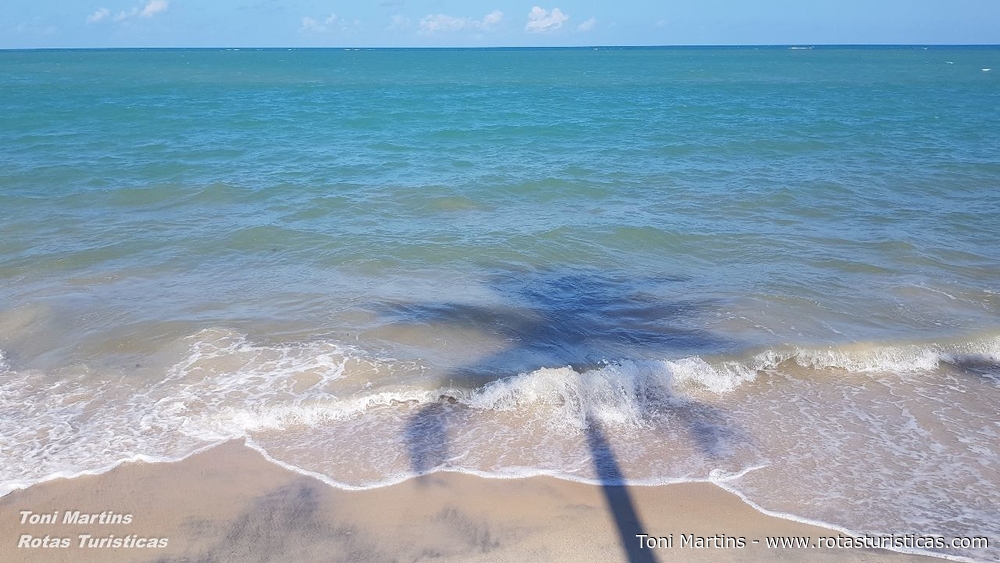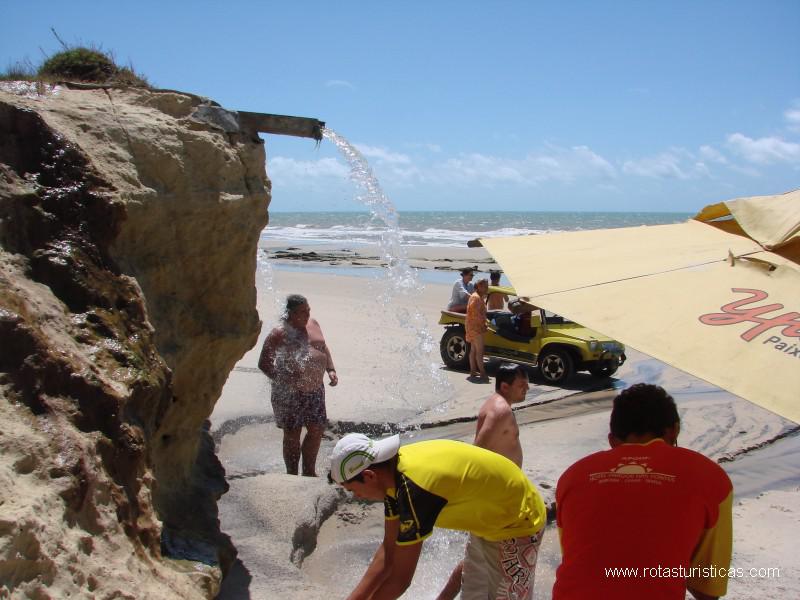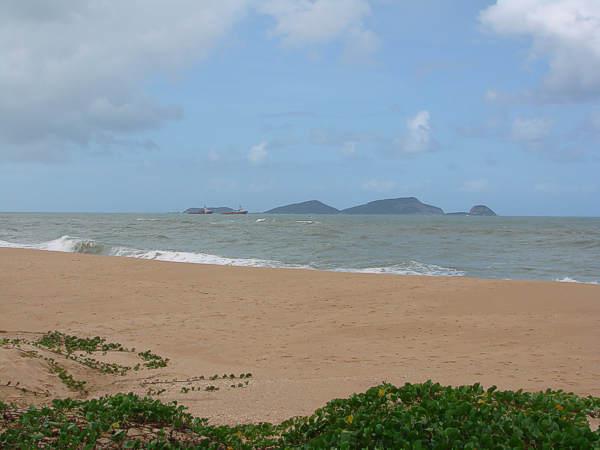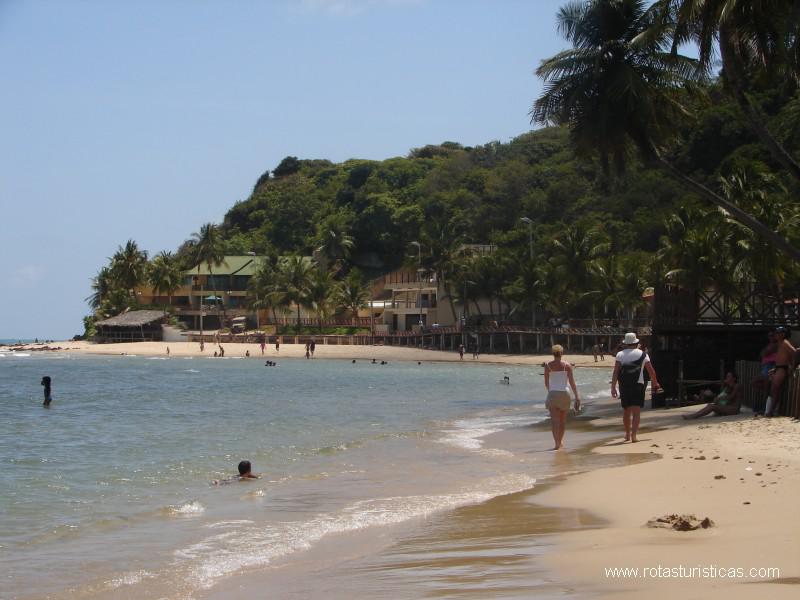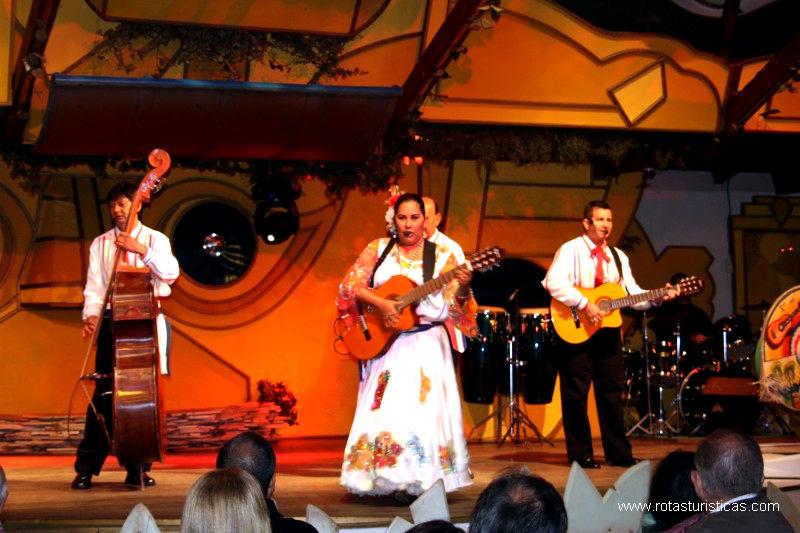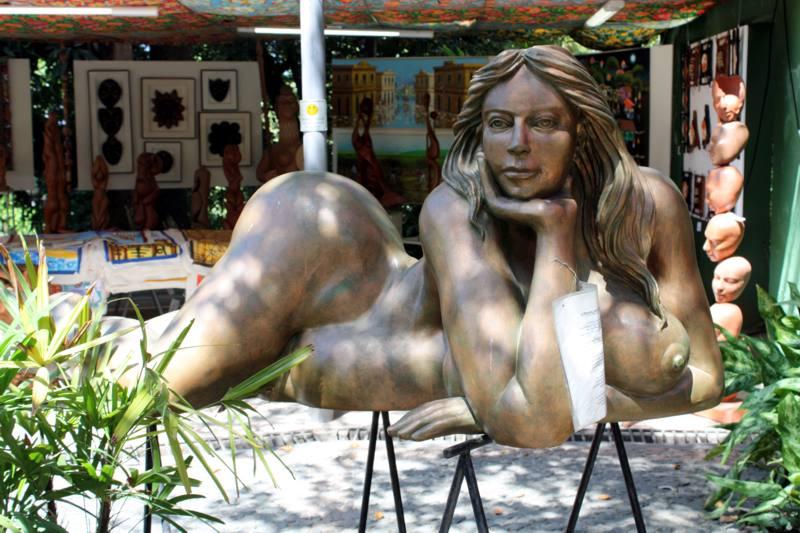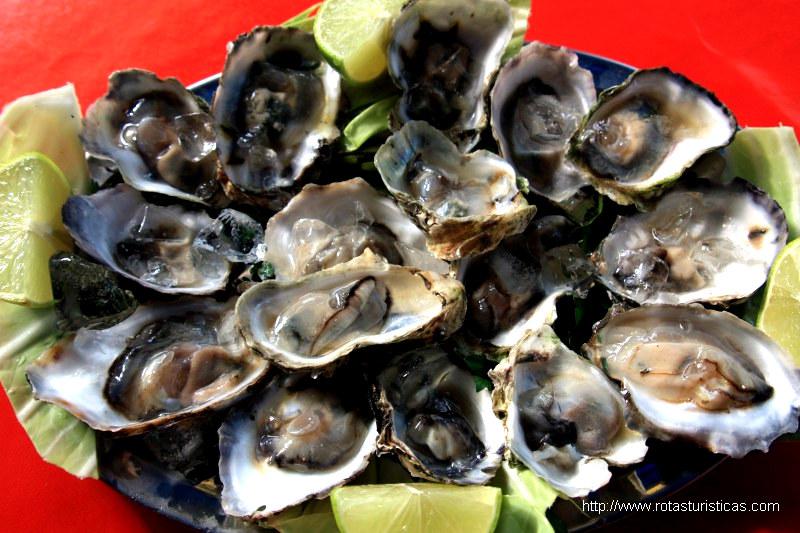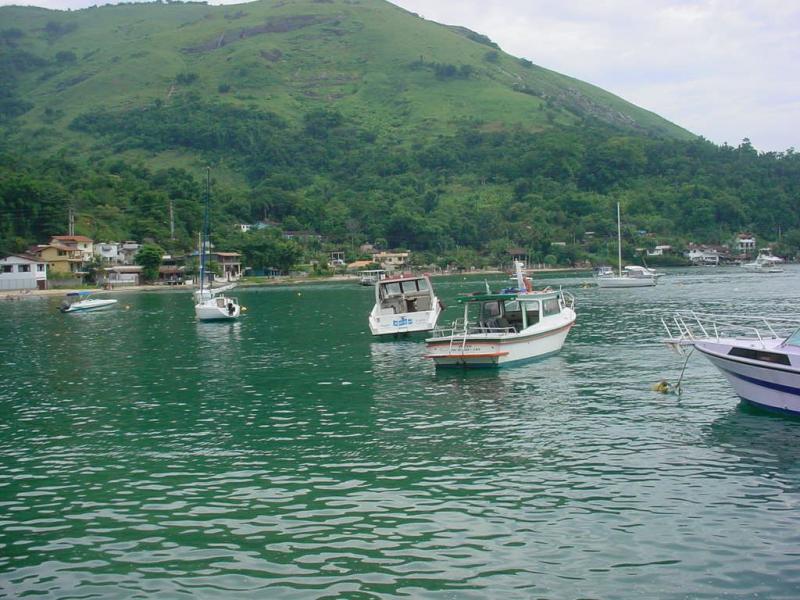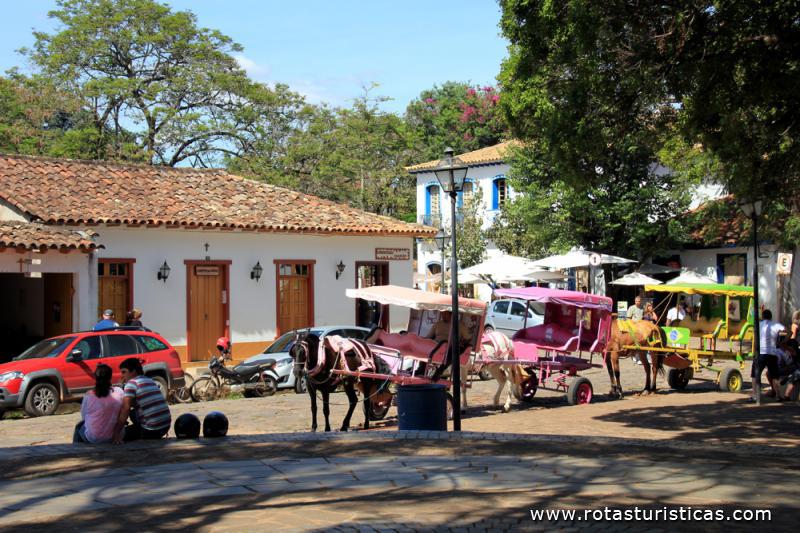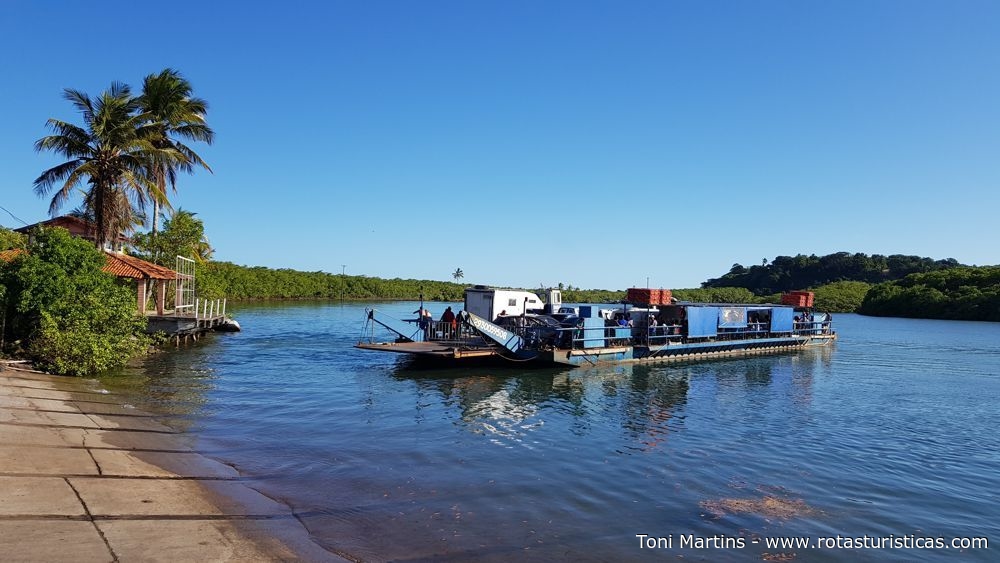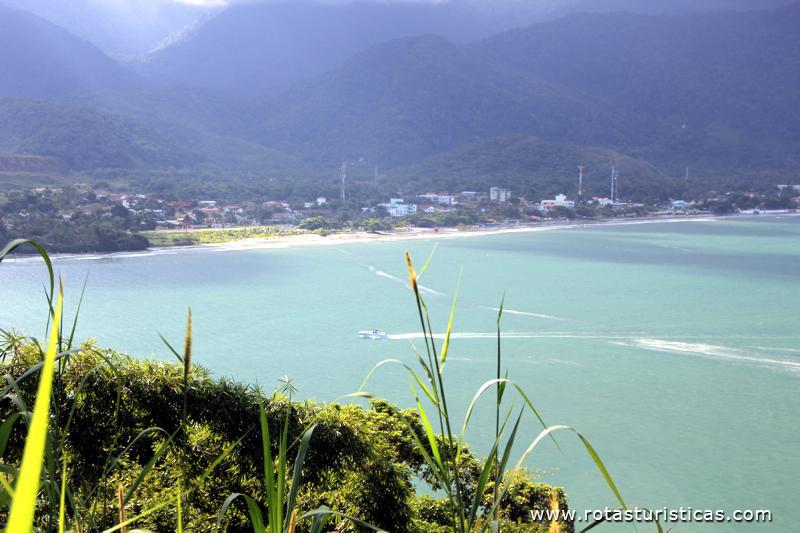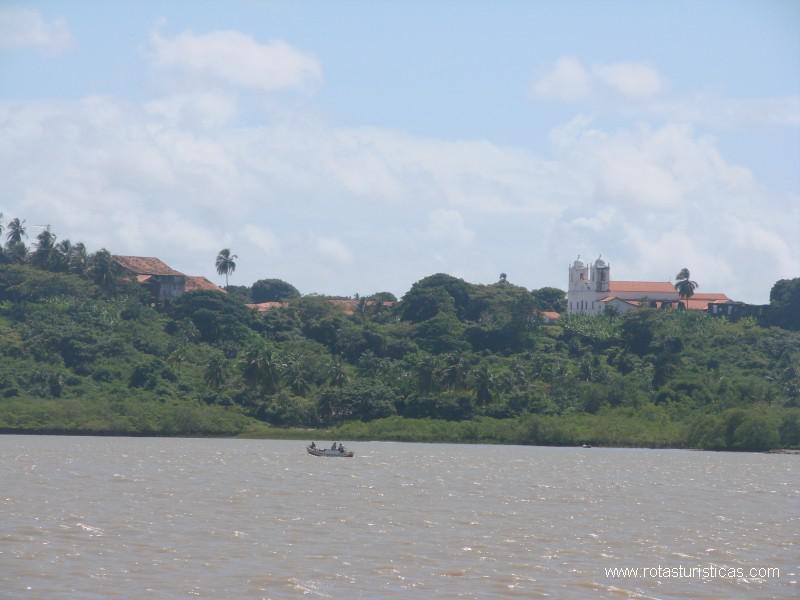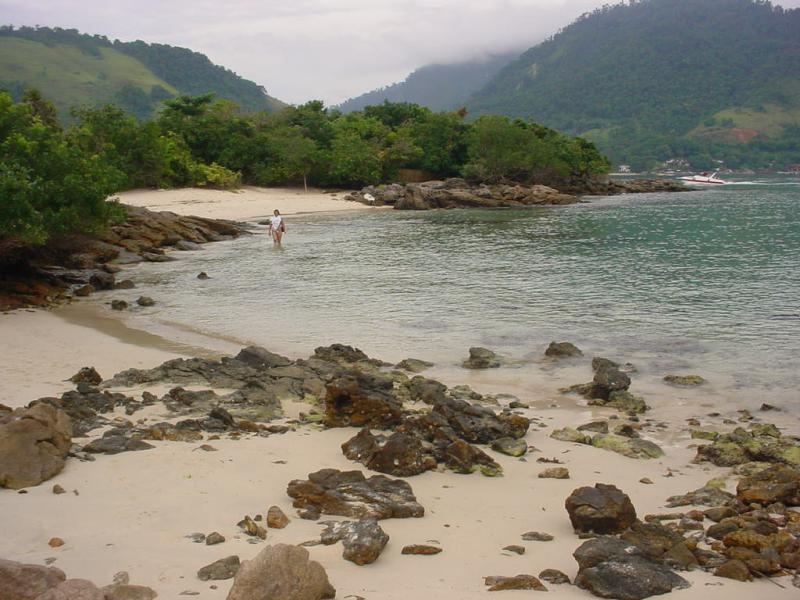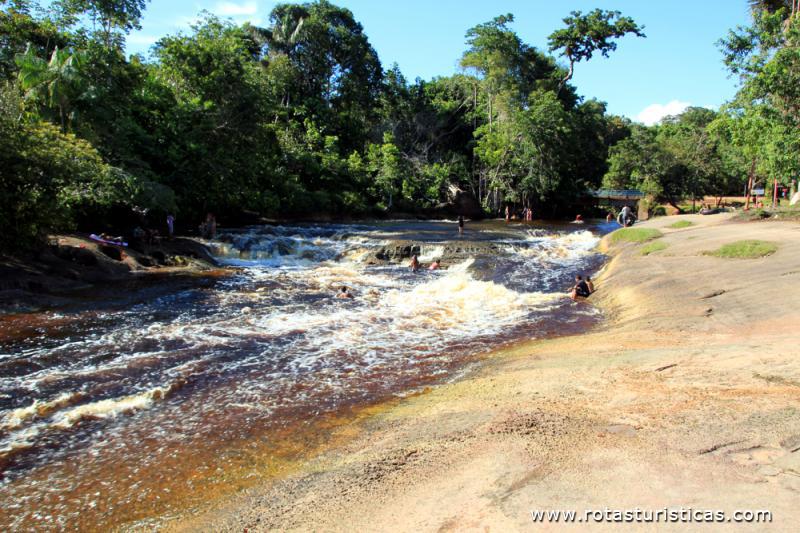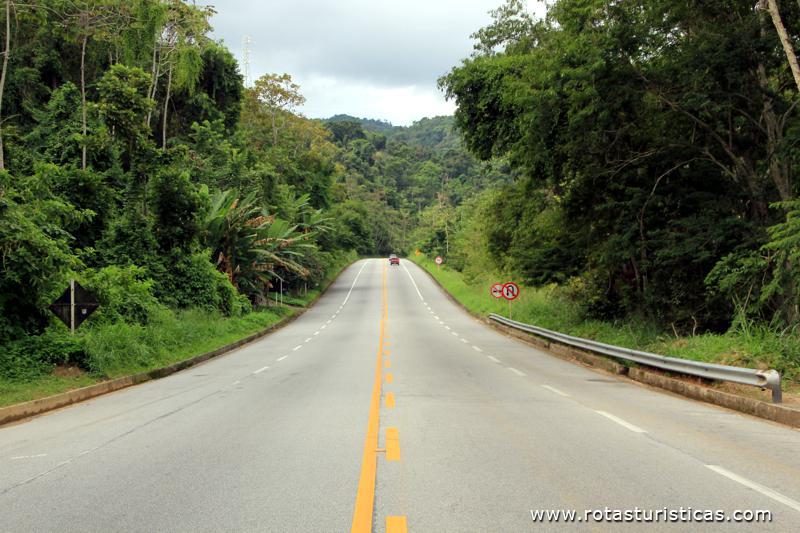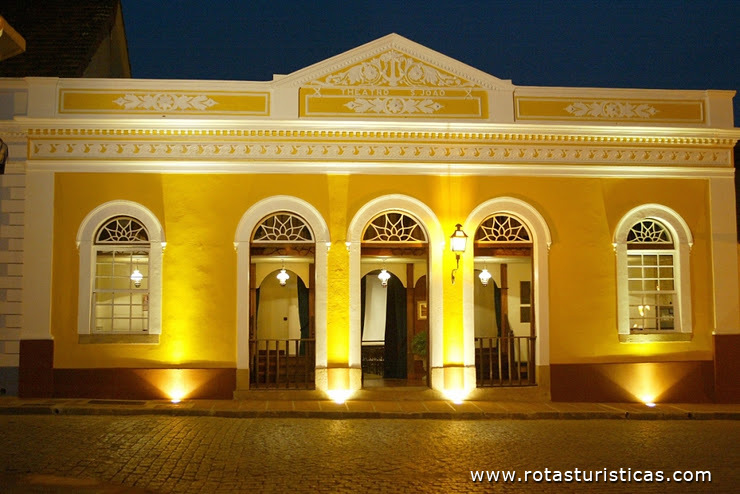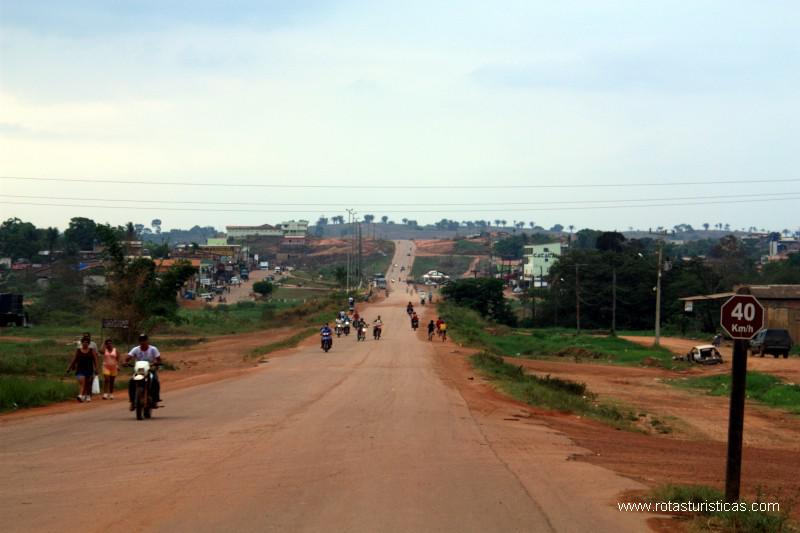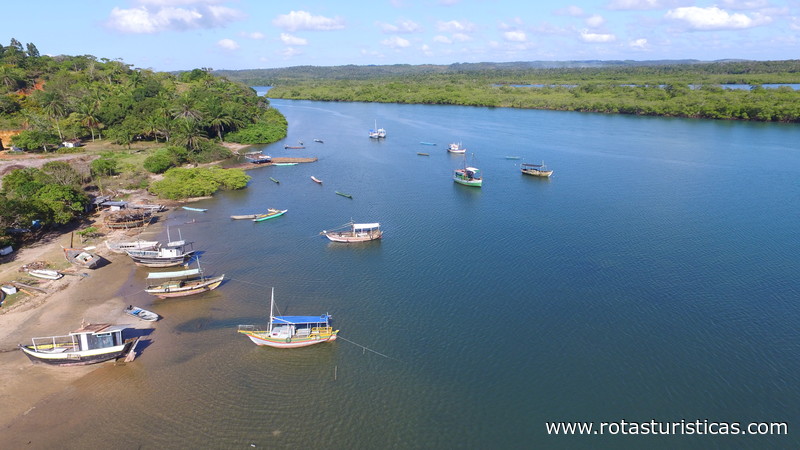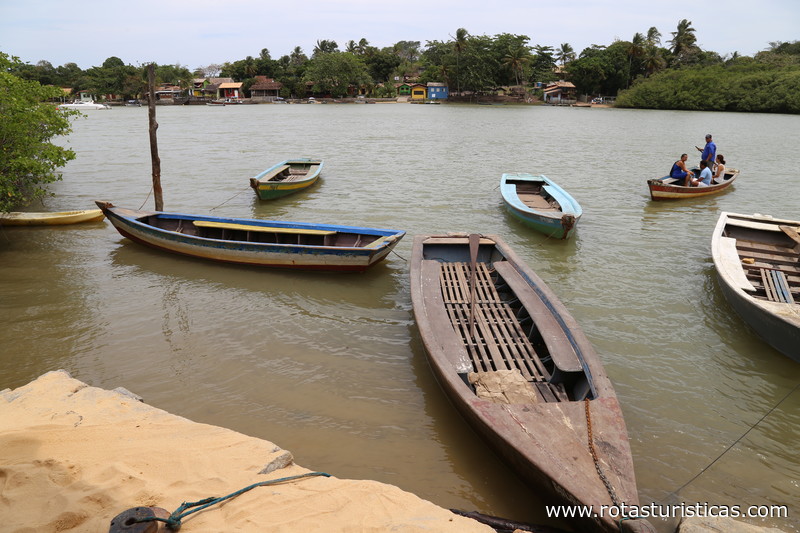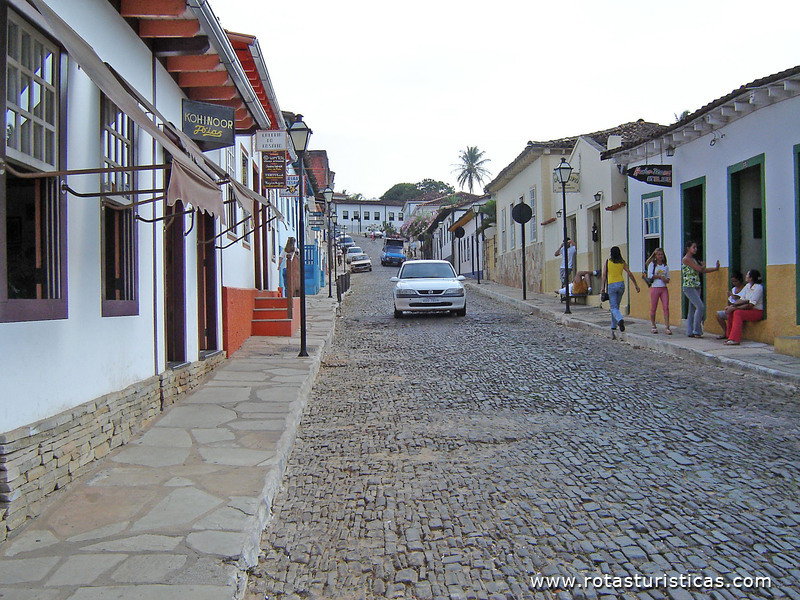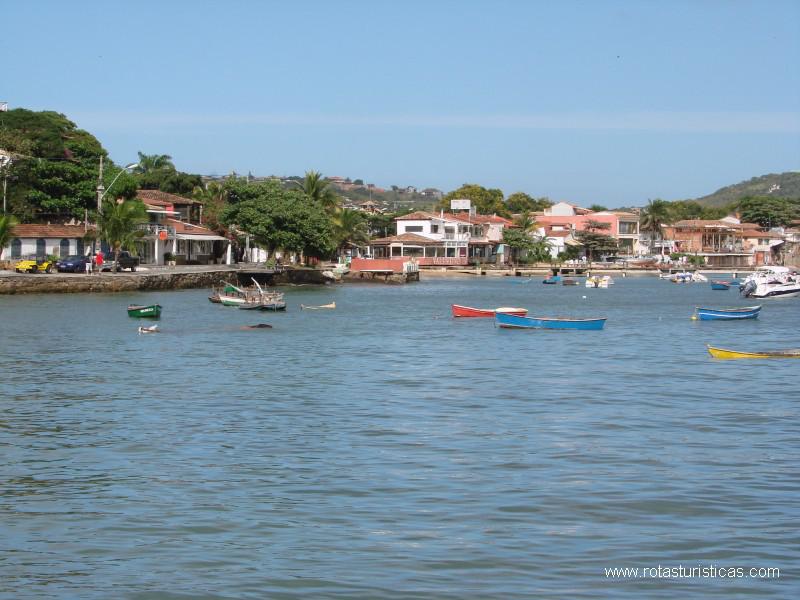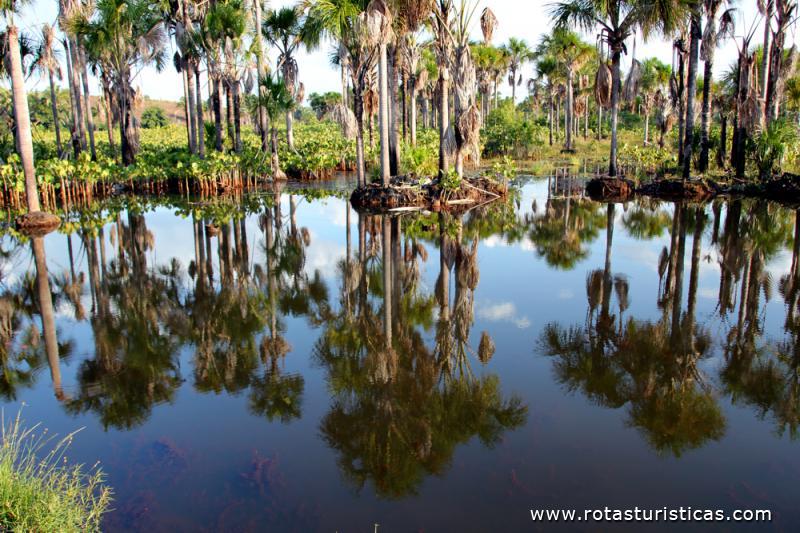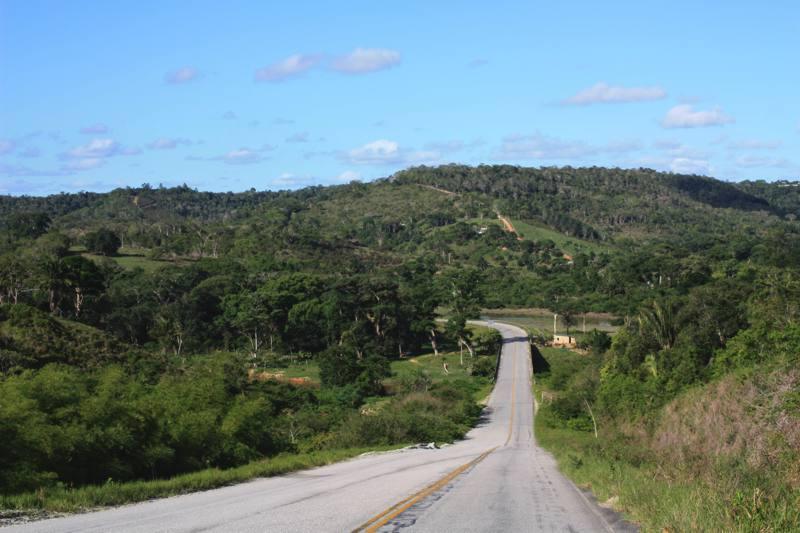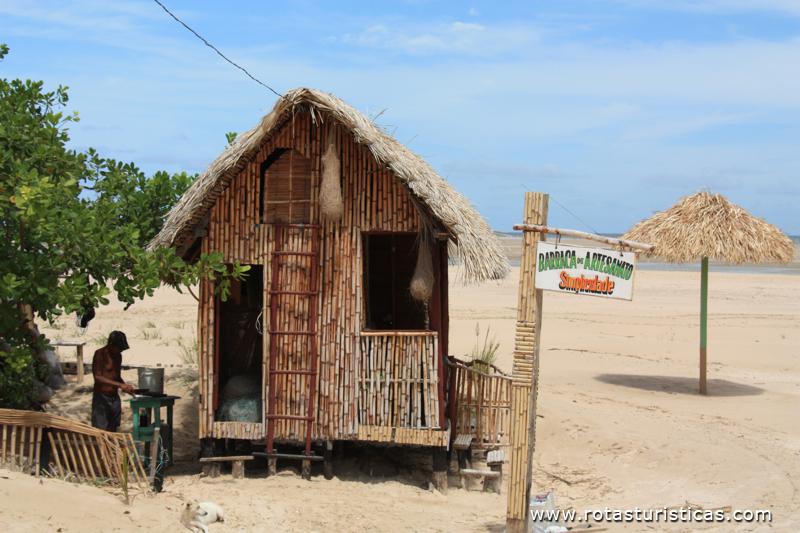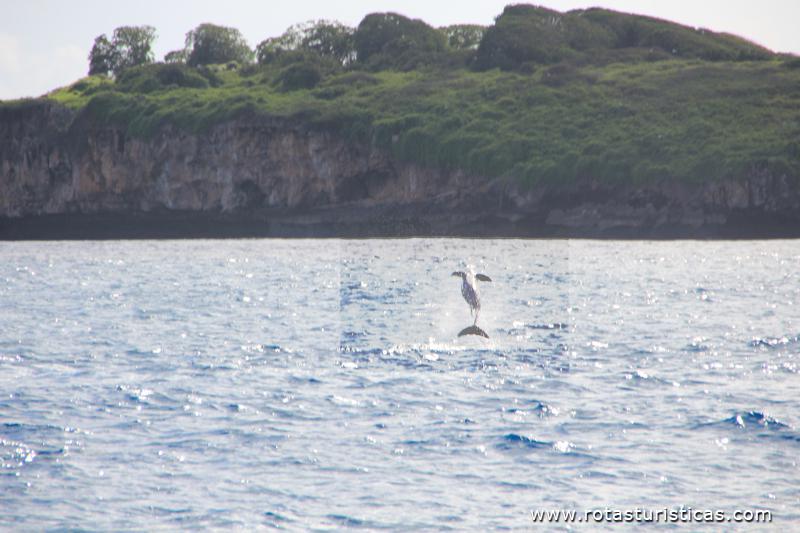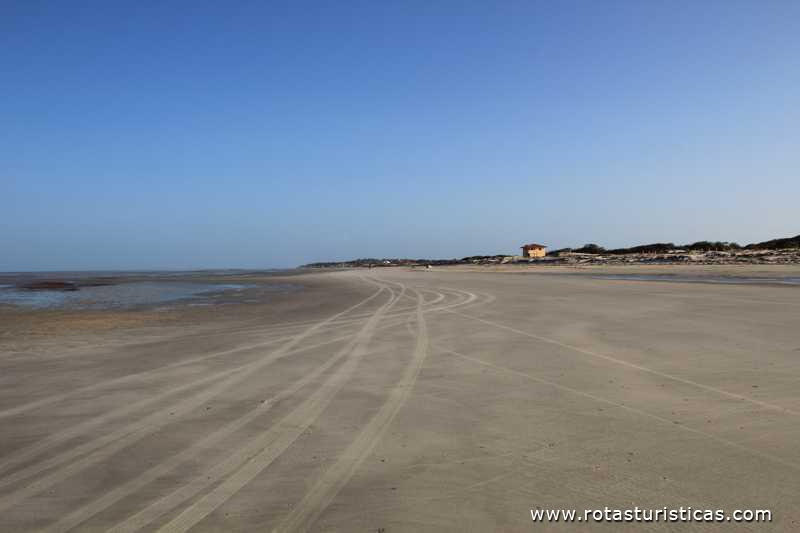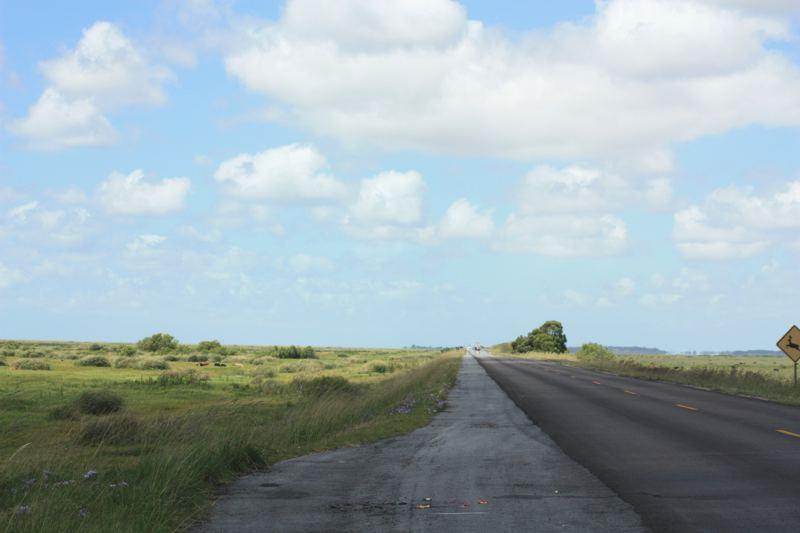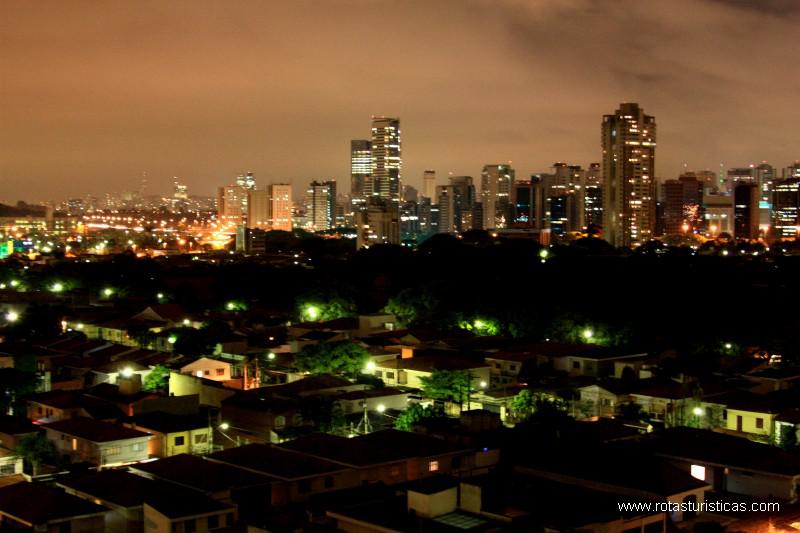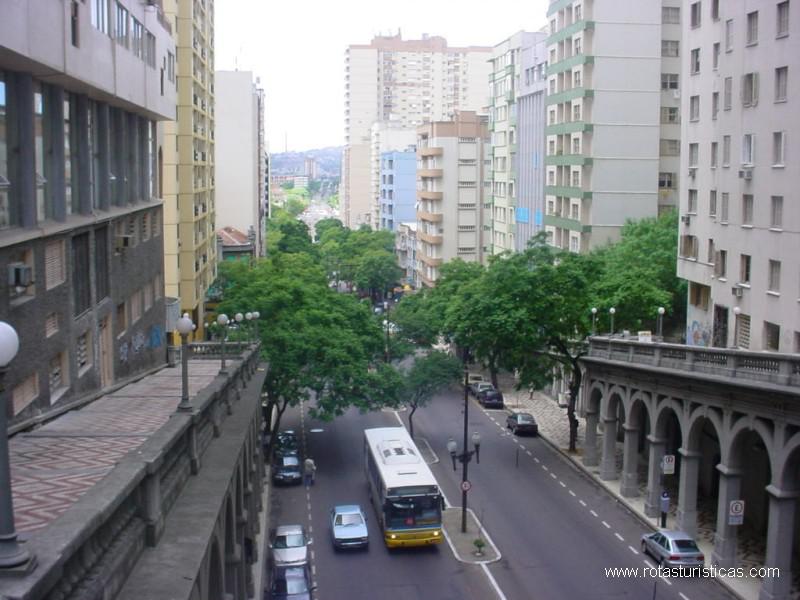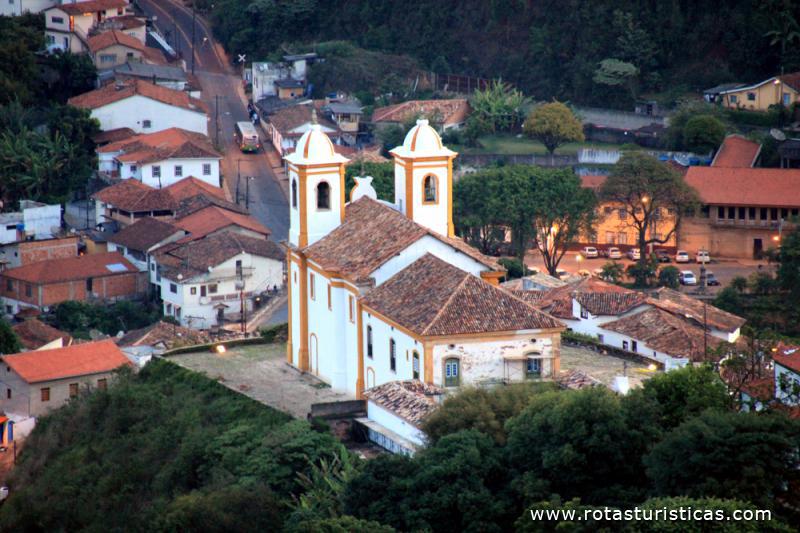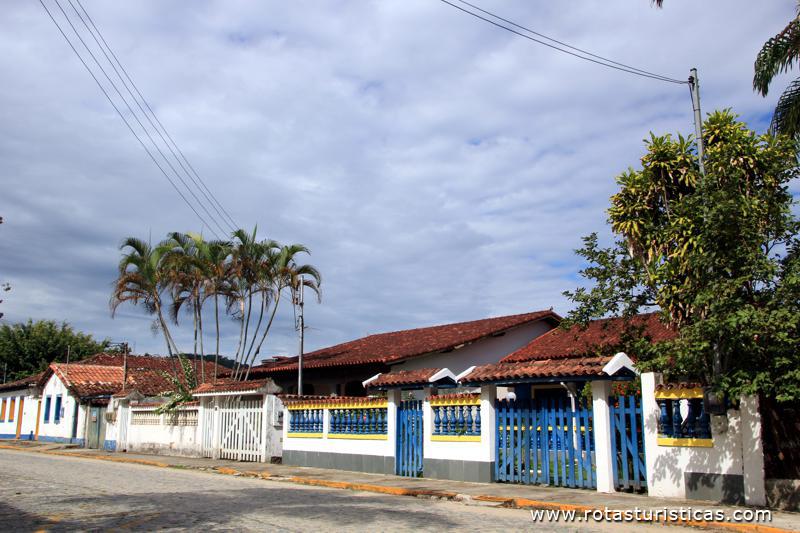Pictures of: Brazil
Location map
Airports
Hotels and other Accommodation
Golf Courses
What to visit
Where to Eat
Where to have fun
Consulates & Embassies
World Nomads
The Travel Insurance with the largest coverage

The Travel Insurance with the largest coverage

Brazil
Brazil, officially the Federative Republic of Brazil is the largest country in South America and the Latin American region, being the fifth largest in the world in territorial area (equivalent to 47% of the South American territory) and population (with more than 201 million of inhabitants).
It is the only country where most of the Portuguese language is spoken in America, and the largest Lusophone country on the planet, besides being one of the most multicultural and ethnically diverse nations, due to the strong immigration from various corners of the world.
Bounded by the Atlantic Ocean to the east, Brazil has a coastline of 7,491 km.
It is bordered on the north by Venezuela, Guyana, Suriname and the French overseas territory of French Guiana; to the northwest by Colombia; to the west by Bolivia and Peru; to the southwest by Argentina and Paraguay and to the south by Uruguay. Several archipelagos form part of the Brazilian territory, such as Fernando de Noronha (the only one inhabited), Atol das Rocas, São Pedro and São Paulo Archipelago and Trindade and Martim Vaz. The country is bordered by all other South American countries except Ecuador and Chile.
Brazil was discovered by the Europeans in 1500, by a Portuguese expedition led by Pedro Álvares Cabral. The present territory of the country, hitherto inhabited by Amerindian natives divided into a few thousand different ethnic and linguistic groups, from this event becomes a colony of the Portuguese overseas empire. The colonial bond was in fact broken in 1808, when the capital of the kingdom was transferred from Lisbon to Rio de Janeiro, after French troops commanded by Napoleon Bonaparte invaded Portugal. In 1815 it becomes a united kingdom with Portugal. Its independence, proclaimed by Dom Pedro I (the first emperor), happened in 1822. Initially independent like Empire, period in which was a parliamentary constitutional monarchy, Brazil became a republic in 1889, due to a military coup headed by Marshal Deodoro da Fonseca (the first president.
Its current Constitution, formulated in 1988, defines Brazil as a presidential federative republic, formed by the union of the Federal District, the 26 states and the 5 570 municipalities.
Brazil's capital is Brasilia.
It is the only country where most of the Portuguese language is spoken in America, and the largest Lusophone country on the planet, besides being one of the most multicultural and ethnically diverse nations, due to the strong immigration from various corners of the world.
Bounded by the Atlantic Ocean to the east, Brazil has a coastline of 7,491 km.
It is bordered on the north by Venezuela, Guyana, Suriname and the French overseas territory of French Guiana; to the northwest by Colombia; to the west by Bolivia and Peru; to the southwest by Argentina and Paraguay and to the south by Uruguay. Several archipelagos form part of the Brazilian territory, such as Fernando de Noronha (the only one inhabited), Atol das Rocas, São Pedro and São Paulo Archipelago and Trindade and Martim Vaz. The country is bordered by all other South American countries except Ecuador and Chile.
Brazil was discovered by the Europeans in 1500, by a Portuguese expedition led by Pedro Álvares Cabral. The present territory of the country, hitherto inhabited by Amerindian natives divided into a few thousand different ethnic and linguistic groups, from this event becomes a colony of the Portuguese overseas empire. The colonial bond was in fact broken in 1808, when the capital of the kingdom was transferred from Lisbon to Rio de Janeiro, after French troops commanded by Napoleon Bonaparte invaded Portugal. In 1815 it becomes a united kingdom with Portugal. Its independence, proclaimed by Dom Pedro I (the first emperor), happened in 1822. Initially independent like Empire, period in which was a parliamentary constitutional monarchy, Brazil became a republic in 1889, due to a military coup headed by Marshal Deodoro da Fonseca (the first president.
Its current Constitution, formulated in 1988, defines Brazil as a presidential federative republic, formed by the union of the Federal District, the 26 states and the 5 570 municipalities.
Brazil's capital is Brasilia.
Tourism
Mountain, beach or waterfalls, agitation or ecotourism, walking or business, weekend, holidays or holidays, Brazil is a country rich in natural beauties and incredible destinations for all tastes.
Tourism in Brazil is a growing and fundamental sector for the economy of several regions of the country. In terms of arrivals of international tourists as the second main destination in South America, and third in Latin America after Mexico and Argentina.
Brazil offers national and international tourists a wide range of options, with natural areas being its most popular tourist product, a combination of eco-tourism with leisure and recreation, mainly sun and beach and adventure tourism, as well as historical tourism and cultural.
Among the most popular destinations are the Amazon Rainforest, beaches and dunes of the Northeast region, the Pantanal, in the Central-West Region, beaches of Rio de Janeiro and Santa Catarina, cultural and historical tourism of Minas Gerais and business trips to the city from Sao Paulo.
One of the special attractions of Brazil is the famous carnival.
The carnival arrived in Brazil in the middle of the 17th century, influenced by the carnival parties that took place in Europe. In countries like France, the carnival happened in the form of urban parades, that is, the carnavalescos wore masks and costumes.
Although of European origin, many characters were incorporated into the Brazilian carnival, such as, for example, King Momo, Pierrô, Columbine, etc.
The earliest carnival blocks, cords, and the famous carvings (Corsicans) emerged at this time, but became more popular in the early twentieth century. The people decorated their cars, fancy themselves and, in groups, paraded through the streets of the cities, giving rise to the floats.
Carnival became increasingly popular in the twentieth century, and grew considerably during this period, due to carnival marches (songs that made carnival more lively).
The first samba school was created on August 12, 1928, in Rio de Janeiro, and was called "Let's Talk".
From this moment the street carnival began to gain a new format. With this, in Rio de Janeiro and São Paulo, new samba schools began to appear. Organized in Leagues of Schools of Samba, they began the first championships to verify which samba school was the most beautiful and lively.
The Northeast remained with the original traditions of street carnival, such as Recife. Already in Bahia, the street carnival counts on the participation of the electric trios, packed with dance songs, especially by axé.
Tourism in Brazil is a growing and fundamental sector for the economy of several regions of the country. In terms of arrivals of international tourists as the second main destination in South America, and third in Latin America after Mexico and Argentina.
Brazil offers national and international tourists a wide range of options, with natural areas being its most popular tourist product, a combination of eco-tourism with leisure and recreation, mainly sun and beach and adventure tourism, as well as historical tourism and cultural.
Among the most popular destinations are the Amazon Rainforest, beaches and dunes of the Northeast region, the Pantanal, in the Central-West Region, beaches of Rio de Janeiro and Santa Catarina, cultural and historical tourism of Minas Gerais and business trips to the city from Sao Paulo.
One of the special attractions of Brazil is the famous carnival.
The carnival arrived in Brazil in the middle of the 17th century, influenced by the carnival parties that took place in Europe. In countries like France, the carnival happened in the form of urban parades, that is, the carnavalescos wore masks and costumes.
Although of European origin, many characters were incorporated into the Brazilian carnival, such as, for example, King Momo, Pierrô, Columbine, etc.
The earliest carnival blocks, cords, and the famous carvings (Corsicans) emerged at this time, but became more popular in the early twentieth century. The people decorated their cars, fancy themselves and, in groups, paraded through the streets of the cities, giving rise to the floats.
Carnival became increasingly popular in the twentieth century, and grew considerably during this period, due to carnival marches (songs that made carnival more lively).
The first samba school was created on August 12, 1928, in Rio de Janeiro, and was called "Let's Talk".
From this moment the street carnival began to gain a new format. With this, in Rio de Janeiro and São Paulo, new samba schools began to appear. Organized in Leagues of Schools of Samba, they began the first championships to verify which samba school was the most beautiful and lively.
The Northeast remained with the original traditions of street carnival, such as Recife. Already in Bahia, the street carnival counts on the participation of the electric trios, packed with dance songs, especially by axé.
Gastronomy
The cuisine of Brazil is the result of a mixture of European, Indian and African ingredients. Many of the techniques of preparation and ingredients are of indigenous origin, having undergone adaptations on the part of the slaves and the Portuguese. These made adaptations of their typical dishes by replacing the missing ingredients with local correspondents. The feijoada, typical dish of the country, is an example of this.
The slaves brought to Brazil from the end of the 16th century, added to the national cuisine elements such as oil palm and couscous. The immigrants from the nineteenth and twentieth centuries, who came from a large number in Europe, brought some news to the national menu and at the same time strengthened the consumption of various ingredients.
The daily food, made in three meals, involves the consumption of coffee with milk, bread, fruit, cakes and sweets, breakfast, beans with rice at lunch, basic meal of Brazilian, to which are sometimes added , the pasta, the meat, the salad and the potato, and at dinner, soups and also the various regional foods.
The distilled drinks were brought by the Portuguese or, like the cachaça, made in the land. The wine is also very consumed, sometimes added to the water and sugar, in the known sangria. The beer in turn began to be consumed in the late eighteenth century and is today one of the most common alcoholic beverages.
The most visible cuisines belong to the states of Minas Gerais and Bahia, being these known throughout Brazilian territory, and even honored in gastronomic fairs of Europe.
The slaves brought to Brazil from the end of the 16th century, added to the national cuisine elements such as oil palm and couscous. The immigrants from the nineteenth and twentieth centuries, who came from a large number in Europe, brought some news to the national menu and at the same time strengthened the consumption of various ingredients.
The daily food, made in three meals, involves the consumption of coffee with milk, bread, fruit, cakes and sweets, breakfast, beans with rice at lunch, basic meal of Brazilian, to which are sometimes added , the pasta, the meat, the salad and the potato, and at dinner, soups and also the various regional foods.
The distilled drinks were brought by the Portuguese or, like the cachaça, made in the land. The wine is also very consumed, sometimes added to the water and sugar, in the known sangria. The beer in turn began to be consumed in the late eighteenth century and is today one of the most common alcoholic beverages.
The most visible cuisines belong to the states of Minas Gerais and Bahia, being these known throughout Brazilian territory, and even honored in gastronomic fairs of Europe.
Weather
The climate of Brazil is diversified as a consequence of varied factors, such as the geographic physiognomy, the territorial extension, the relief and the dynamics of the air masses.
This last factor is of extreme importance because it acts directly in both temperature and rainfall, provoking regional climatic differences. The air masses that interfere most directly are equatorial (continental and Atlantic), tropical (continental and Atlantic) and Atlantic polar.
Brazil presents a very humid climate with diverse characteristics, such as the very hot humid (equatorial), in areas of the North region; (subtropical), in the southern region of Brazil, in the south and the São Paulo plateau of the state of São Paulo, and very humid (tropical) in a narrow coastal strip from São Paulo to Rio de Janeiro, Vitória, south of Bahia until Salvador, south of Sergipe and north of Alagoas.
The humid climate, also with several characteristics: warm humid climate (equatorial), in Acre, Rondônia, Roraima, north of Mato Grosso, east of Amazonas, Pará, Amapá and small stretch west of Maranhão; very hot (tropical) humid climate in São Paulo and southern Mato Grosso do Sul, and the hot (tropical) humid climate in Mato Grosso do Sul, south of Goiás, southwest and a narrow strip in the west of Minas Gerais, and a strip from Sergipe and from the coast of Alagoas to Paraíba.
The warm (tropical) semi humid climate corresponds to the southern area of Mato Grosso do Sul, Goiás, south of Maranhão, southwest of Piauí, Minas Gerais, a very narrow strip east of Bahia, west of Rio Grande do Norte and one part of southern Bahia.
The semi-arid climate, with diversification as to the humidity, corresponding to a wide area of the warm tropical climate. Thus, the semi-arid climate is mild, in the northeast of Maranhão, Piauí and the southern part of Bahia; the semi-arid median, in Ceará, Rio Grande do Norte, Paraíba, Pernambuco and inland of Bahia; the semi-arid fort, north of the Bay and interior of Paraíba, and the semi-arid very strong, in small portions of the interior of Paraíba, Pernambuco and north of Bahia.
The highest temperature recorded officially in Brazil was 44.7 ° C in Bom Jesus, Piauí, on November 21, 2005, surpassing the official record of Orleans, Santa Catarina, of 44.6 ° C, of January 6, 1963 .
The lowest recorded temperature was -17.8 ° C in Morro da Igreja, in Urubici, Santa Catarina, on June 29, 1996.
The lowest officially registered temperature in the country was -14.0 ° C, in the municipality of Caçador, in the same state, on June 11, 1952.
According to the National Institute of Meteorology (INMET), the largest accumulated rainfall in 24 hours already observed in the country was 404.8 mm, in Florianópolis, Santa Catarina, on November 15, 1991.
However unofficial sources indicate the occurrence of 622.5 mm in the town of Itapanhaú, municipality of Biritiba Mirim, São Paulo, on June 20, 1947.
This last factor is of extreme importance because it acts directly in both temperature and rainfall, provoking regional climatic differences. The air masses that interfere most directly are equatorial (continental and Atlantic), tropical (continental and Atlantic) and Atlantic polar.
Brazil presents a very humid climate with diverse characteristics, such as the very hot humid (equatorial), in areas of the North region; (subtropical), in the southern region of Brazil, in the south and the São Paulo plateau of the state of São Paulo, and very humid (tropical) in a narrow coastal strip from São Paulo to Rio de Janeiro, Vitória, south of Bahia until Salvador, south of Sergipe and north of Alagoas.
The humid climate, also with several characteristics: warm humid climate (equatorial), in Acre, Rondônia, Roraima, north of Mato Grosso, east of Amazonas, Pará, Amapá and small stretch west of Maranhão; very hot (tropical) humid climate in São Paulo and southern Mato Grosso do Sul, and the hot (tropical) humid climate in Mato Grosso do Sul, south of Goiás, southwest and a narrow strip in the west of Minas Gerais, and a strip from Sergipe and from the coast of Alagoas to Paraíba.
The warm (tropical) semi humid climate corresponds to the southern area of Mato Grosso do Sul, Goiás, south of Maranhão, southwest of Piauí, Minas Gerais, a very narrow strip east of Bahia, west of Rio Grande do Norte and one part of southern Bahia.
The semi-arid climate, with diversification as to the humidity, corresponding to a wide area of the warm tropical climate. Thus, the semi-arid climate is mild, in the northeast of Maranhão, Piauí and the southern part of Bahia; the semi-arid median, in Ceará, Rio Grande do Norte, Paraíba, Pernambuco and inland of Bahia; the semi-arid fort, north of the Bay and interior of Paraíba, and the semi-arid very strong, in small portions of the interior of Paraíba, Pernambuco and north of Bahia.
The highest temperature recorded officially in Brazil was 44.7 ° C in Bom Jesus, Piauí, on November 21, 2005, surpassing the official record of Orleans, Santa Catarina, of 44.6 ° C, of January 6, 1963 .
The lowest recorded temperature was -17.8 ° C in Morro da Igreja, in Urubici, Santa Catarina, on June 29, 1996.
The lowest officially registered temperature in the country was -14.0 ° C, in the municipality of Caçador, in the same state, on June 11, 1952.
According to the National Institute of Meteorology (INMET), the largest accumulated rainfall in 24 hours already observed in the country was 404.8 mm, in Florianópolis, Santa Catarina, on November 15, 1991.
However unofficial sources indicate the occurrence of 622.5 mm in the town of Itapanhaú, municipality of Biritiba Mirim, São Paulo, on June 20, 1947.
Currency
Real
Official language
Portuguese
Documentation required
The tourist visa will be granted to foreigners who travel to Brazil in a recreational or visiting nature, with no intention to immigrate or intend to exercise paid activity.
Tourist visas will also be awarded in the case of artistic competitions and sports competitions in which there are no ticket collection, nor remuneration paid by Brazilian source, as well as in the case of unpaid participants of congresses, conferences and seminars.
DOCUMENTATION
Passport, valid for six months or more;
Proof of means of subsistence (bank account statement or document proving the possession of financial resources, at the discretion of the consular authority);
Proof of reservation with date of entry and exit of the Brazilian territory or travel ticket;
1 Recent photograph, 5x7 size or pass type, white and dated background;
1 Form "Application for Visa" duly completed and signed;
Unaccompanied minors, or in the company of one of the parents: authorization is required from both parents to issue a visa, in the first case, or from the non-traveling parent, in the second, with the signatures duly recognized in Public notary.
The Consulate General of Brazil reserves the right to request any other document that it deems necessary, in addition to those already enumerated above.
CONSULAR FEES
The rates vary according to the nationality, being between 20,00 euros and 100,00 euros, depending on the nationality. Passport holders issued by the United States of America are charged a fee of € 160.00 for visa processing.
Tourist visas will also be awarded in the case of artistic competitions and sports competitions in which there are no ticket collection, nor remuneration paid by Brazilian source, as well as in the case of unpaid participants of congresses, conferences and seminars.
DOCUMENTATION
Passport, valid for six months or more;
Proof of means of subsistence (bank account statement or document proving the possession of financial resources, at the discretion of the consular authority);
Proof of reservation with date of entry and exit of the Brazilian territory or travel ticket;
1 Recent photograph, 5x7 size or pass type, white and dated background;
1 Form "Application for Visa" duly completed and signed;
Unaccompanied minors, or in the company of one of the parents: authorization is required from both parents to issue a visa, in the first case, or from the non-traveling parent, in the second, with the signatures duly recognized in Public notary.
The Consulate General of Brazil reserves the right to request any other document that it deems necessary, in addition to those already enumerated above.
CONSULAR FEES
The rates vary according to the nationality, being between 20,00 euros and 100,00 euros, depending on the nationality. Passport holders issued by the United States of America are charged a fee of € 160.00 for visa processing.
Health care
The yellow fever vaccination certificate is required for those who have traveled in the ninety days prior to travel to Brazil, for: Angola, Bolivia, Benin, Burkina, Cameroon, Colombia, Democratic Republic of the Congo, Ecuador, French Guiana , Gabon, Ghana, The Gambia, Republic of Guinea, Liberia, Nigeria, Peru, Sierra Leone, Sudan and Venezuela.
Immunization against yellow fever is advised for those who intend to travel to certain Brazilian cities and vaccination is required for others.
Note:
This vaccine is required to pass through Cayenne, Guyana and recommended in the regions of the Amazon and Pantanal.
Brazilian public health services are modest while private health services are good.
We recommend taking unlimited health insurance to insure any medical expenses.
Immunization against yellow fever is advised for those who intend to travel to certain Brazilian cities and vaccination is required for others.
Note:
This vaccine is required to pass through Cayenne, Guyana and recommended in the regions of the Amazon and Pantanal.
Brazilian public health services are modest while private health services are good.
We recommend taking unlimited health insurance to insure any medical expenses.
Telecommunications and Electricity
CELL PHONES AND INTERNET
Telephones: International telephone code of Brazil: 0055.
Mobile phones / Mobile phones: The technologies used for mobile phones in Brazil are GSM, GPRS, EDGE, UMTS, HSDPA, HSPA and LTE. Networks are widespread across the country, but in large sparsely populated areas they do not yet exist.
Mobile network operators: Vivo, Tim, Claro, Oi, Nextel, Ctbc, Sercomtel Celular.
Internet: Many hotels have internet connections peraneuma fee or free and there are many Internet cafes in every city in the country.
ELECTRIC OUTLETS
Electricity: The electricity in Brazil is 127/220 Volts, 60 Hz. Recommended a transformer, because the electric current in Brazil is not always the same voltage. The electric current in Brazil is basically 220 volts, and in Rio de Janeiro and São Paulo it is almost exclusively 110 or 120 volts, and in Salvador and Manaus it is 127 volts.
Electrical outlets: The electrical outlets in Brazil are very diverse. In the country there are the following types of outlets: A, B, C, I, N. Since 2010 the new Brazilian electrical outlet is type N.
Telephones: International telephone code of Brazil: 0055.
Mobile phones / Mobile phones: The technologies used for mobile phones in Brazil are GSM, GPRS, EDGE, UMTS, HSDPA, HSPA and LTE. Networks are widespread across the country, but in large sparsely populated areas they do not yet exist.
Mobile network operators: Vivo, Tim, Claro, Oi, Nextel, Ctbc, Sercomtel Celular.
Internet: Many hotels have internet connections peraneuma fee or free and there are many Internet cafes in every city in the country.
ELECTRIC OUTLETS
Electricity: The electricity in Brazil is 127/220 Volts, 60 Hz. Recommended a transformer, because the electric current in Brazil is not always the same voltage. The electric current in Brazil is basically 220 volts, and in Rio de Janeiro and São Paulo it is almost exclusively 110 or 120 volts, and in Salvador and Manaus it is 127 volts.
Electrical outlets: The electrical outlets in Brazil are very diverse. In the country there are the following types of outlets: A, B, C, I, N. Since 2010 the new Brazilian electrical outlet is type N.
Curiosities
Brazil is a vast country in many ways, we can mention the great territorial extent, the different landscapes and biomes present in nature, but also has a very diverse and at the same time unique ethnic and cultural background. Get to know a little more about the country, a little of its History of the Brazilian People.
Population
Brazil has about 190,755,799 inhabitants, which is equivalent to three times the population of France; 5 times the population of California (most populous US state);
The Brazilian democracy and its voting system is praised internationally, here all citizens have the duty to vote, in addition, electronic ballot boxes are used which allows more security and speed in the calculation of the result of the Election.
When the country was discovered there were about 6 million Indians in Brazil. Currently there are around 300 thousand, in 215 tribes, 55 of them still without contact with civilization.
The slave trade took place between 1550 and 1850, and brought about 4 million Africans to work as slaves. In 1880, two-thirds of the Brazilian population were black or mulatto.
It is the country most affected by lightning in the world, according to a study by the National Institute of Space Research (INPE);
The Amazon Basin is the largest in the world with 3.9 million square kilometers in Brazilian territory. The Amazon River, the main axis of the Basin, has about 7,000 tributaries, and in some stretches is 50 kilometers wide.
The largest river island in the world is Bananal.
Brazil is the country with the most monkeys in the world.
The Victory Regia, one of the symbols of the Amazon, is the largest flower in the world, measuring 2 meters in diameter.
The Pantanal is the largest wetland in the world, where several biomes are concentrated as part of the Amazon and Cerrado, with great biodiversity.
Cities
Helicopter traffic in São Paulo is the third largest in the world.
Despite having a hydrographical network privileged by the abundance of waters and great extensions, the fluvial and lacustrine navigation is little practiced in Brazil.
The first World Cup that Brazilians saw on television was 1962, however the games were broadcast two days late, because the Videotape tapes arrived by plane.
History, Culture and Art
Brazil was once called the Land of Vera Cruz, then as Land of the Parrots for about three years, until it was definitively called Brazil. But the Indians called Brazil from Pindorama, which means "land of palm trees."
The National Symbols are four: the flag, the anthem, the seal and the weapons.
The first public session of cinema was held in Rio de Janeiro on July 8, 1896. Two years later, Afonso Segreto made the first Brazilian film, which had scenes from Guanabara Bay.
The most popular songs of culture are Aquarela do Brasil, Tico Tico no Fubá, Brasileirinho, Garota de Ipanema, among other genres Samba, Chorinho and Bossa Nova.
The culture and language was greatly influenced by the natives, for example the name Rio Tietê, Maracanã, Vale do Anhangabaú, Praia de Jericoacoara, among many others. In addition, eating habits, such as Tapioca, and cultural as legends and accessories are part of day to day.
The Street Art is a great contemporary trend, a great example is the Graffiti, paintings done on walls, bridges and various locations. This art is influenced by Hip Hop culture.
Population
Brazil has about 190,755,799 inhabitants, which is equivalent to three times the population of France; 5 times the population of California (most populous US state);
The Brazilian democracy and its voting system is praised internationally, here all citizens have the duty to vote, in addition, electronic ballot boxes are used which allows more security and speed in the calculation of the result of the Election.
When the country was discovered there were about 6 million Indians in Brazil. Currently there are around 300 thousand, in 215 tribes, 55 of them still without contact with civilization.
The slave trade took place between 1550 and 1850, and brought about 4 million Africans to work as slaves. In 1880, two-thirds of the Brazilian population were black or mulatto.
It is the country most affected by lightning in the world, according to a study by the National Institute of Space Research (INPE);
The Amazon Basin is the largest in the world with 3.9 million square kilometers in Brazilian territory. The Amazon River, the main axis of the Basin, has about 7,000 tributaries, and in some stretches is 50 kilometers wide.
The largest river island in the world is Bananal.
Brazil is the country with the most monkeys in the world.
The Victory Regia, one of the symbols of the Amazon, is the largest flower in the world, measuring 2 meters in diameter.
The Pantanal is the largest wetland in the world, where several biomes are concentrated as part of the Amazon and Cerrado, with great biodiversity.
Cities
Helicopter traffic in São Paulo is the third largest in the world.
Despite having a hydrographical network privileged by the abundance of waters and great extensions, the fluvial and lacustrine navigation is little practiced in Brazil.
The first World Cup that Brazilians saw on television was 1962, however the games were broadcast two days late, because the Videotape tapes arrived by plane.
History, Culture and Art
Brazil was once called the Land of Vera Cruz, then as Land of the Parrots for about three years, until it was definitively called Brazil. But the Indians called Brazil from Pindorama, which means "land of palm trees."
The National Symbols are four: the flag, the anthem, the seal and the weapons.
The first public session of cinema was held in Rio de Janeiro on July 8, 1896. Two years later, Afonso Segreto made the first Brazilian film, which had scenes from Guanabara Bay.
The most popular songs of culture are Aquarela do Brasil, Tico Tico no Fubá, Brasileirinho, Garota de Ipanema, among other genres Samba, Chorinho and Bossa Nova.
The culture and language was greatly influenced by the natives, for example the name Rio Tietê, Maracanã, Vale do Anhangabaú, Praia de Jericoacoara, among many others. In addition, eating habits, such as Tapioca, and cultural as legends and accessories are part of day to day.
The Street Art is a great contemporary trend, a great example is the Graffiti, paintings done on walls, bridges and various locations. This art is influenced by Hip Hop culture.
Tips
Before traveling, inquire about the road conditions of access to your destination;
Check that there are banks or ATMs that you use at the destination you choose;
Check fuel stations;
Review your vehicle and make sure the documentation is current;
Inquire about the distances, access conditions and prices of the attractions you want to visit;
Try to make hotel reservations in advance,
Hire guides only at trusted agencies or locations.
Check that there are banks or ATMs that you use at the destination you choose;
Check fuel stations;
Review your vehicle and make sure the documentation is current;
Inquire about the distances, access conditions and prices of the attractions you want to visit;
Try to make hotel reservations in advance,
Hire guides only at trusted agencies or locations.
Other tourist destinations in:
Brazil
Brazil
Other world tourist destinations
Why to book with BOOK HOTEL MADEIRA
The best prices
Our partnerships with the world´s largest operators offer research on the best market prices.
More options
At Rotas Turisticos you can book the hotel, buy the air ticket, book the transfer from the airport to the hotel and vice versa, book the local excursions, rent the car, take travel insurance and consult the places to visit and where to go.
Holiday Tips & Destinations
Hundreds of holiday destinations with all the options that allow you to easily choose the destination that best suits your dream vacation.
BOOK HOTEL MADEIRA
Links

